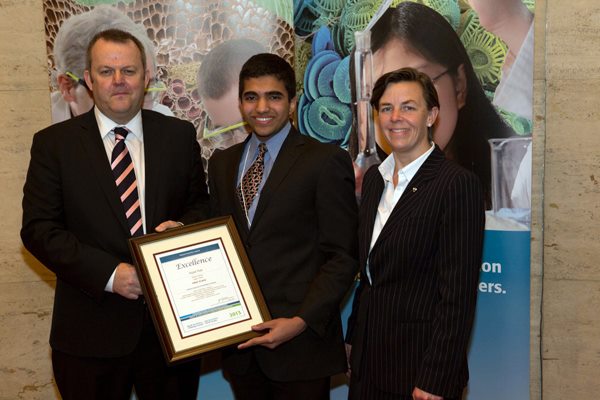Indo-Canadian student gives boost to cancer treatment
OTTAWA—A Canadian high school student has improved an ineffective experimental cancer therapy with a simple tweak—pairing it with antibiotics—earning accolades Tuesday from a panel of eminent scientists.
Cancer “photothermal therapy”—or PTT—involves injecting a patient with gold nanoparticles. These then accumulate in tumors and, when heated using light, attack the cancer cells.
The idea has shown promise but is not very effective because the cancer cells fight back, producing heat-shock proteins to protect themselves.
India-born high school student Arjun Nair, 16, showed how an antibiotic (17-AAG) may overcome the defenses deployed by cancer cells and make the treatment more effective.
The discovery earned Nair the top prize in the 20th Sanofi BioGENEius Challenge Canada, after he spent two years working on his idea at the University of Calgary’s Nanoscience Labs in Alberta.
Article continues after this advertisement“Proof-of-concepts were developed and tested in order to demonstrate the viability of PTT,” Nair said in a statement. “Moreover, after analyzing the literature a mathematical model was developed to evaluate a theoretical synergetic treatment.”
Article continues after this advertisementIn an interview with AFP, Nair said he began looking into this after his grandmother was diagnosed with cancer. “She suffered a lot through therapy, so I was looking at cancer in general and read a lot about treatments,” he said.
At the same time, Nair noticed cancer projects had become staples of science fairs across Canada, and so decided to take on the challenge himself.
A total of 208 high school students collaborating on 123 projects, all mentored in professional labs over several months, took part in the annual competition.
In addition to a Can$5,000 (US$4,919) award for his discovery, Nair also won a Can$1,000 (US$984) prize for the project with the greatest commercial potential.
“It’s the start of a fantastic research career for this young man,” said Jon Fairest, president of biotech Sanofi Canada after presenting Nair with the awards.
More work is needed before Nair’s paired therapy reaches a stage in which it can be commercialized, but he insists that it is a viable cancer treatment option and one that he aims to continue working on.
Prizes were also awarded for research into how genetic mutations naturally help some HIV patients escape symptoms, how to tailor stem cell treatments for Parkinson’s disease, a potential new therapy to reduce the severity of diabetes, and a possible novel tactic to fight the world’s deadliest brain cancer.
